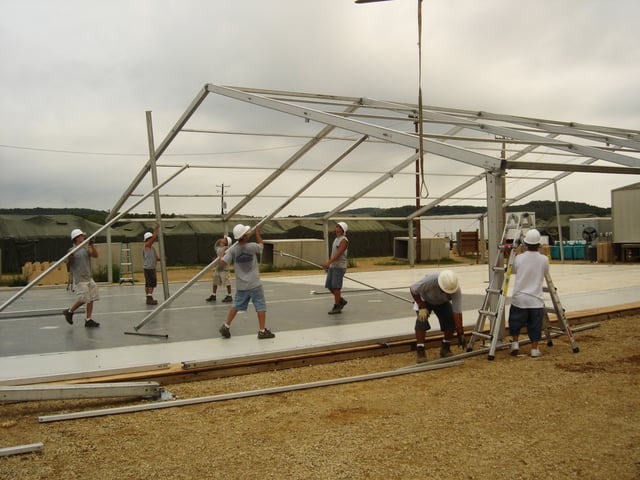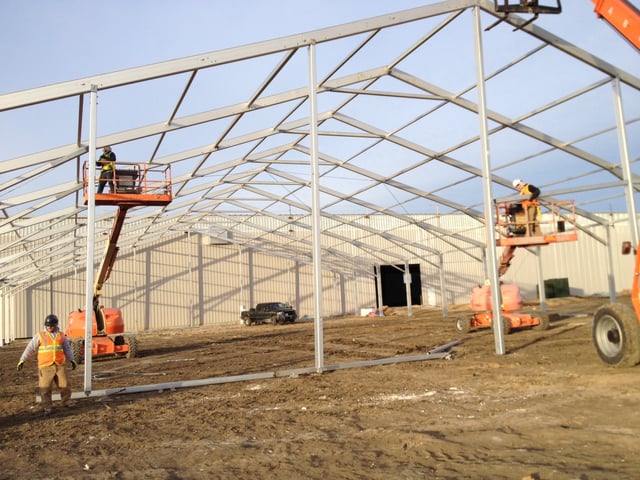You probably already know temporary fabric structures offer you immediate solutions and great flexibility, but before you design your building solution, follow the old advice to start from the ground up. Unlike traditional buildings which have very specific foundation requirements, temporary fabric structures and semi-permanent buildings, like temporary warehouses, can often be built on any ground surface – from concrete and asphalt to gravel, dirt or even packed sand.

Maybe you have a few options for where to build, or maybe you have a location identified but you’re wondering what steps to take to prepare the ground surface for building. As you weigh out your options, here are some things to consider to prevent problems from surfacing with your ground surface.
- Should you modify your ground surface? Think beyond up-front costs and consider how you plan to use your structure. Are you looking for storage for your trucks and heavy equipment? If you’ve already been driving on the area, it’s likely your ground is already packed enough to build on. Are you putting up a break area for your employees on your construction site? It might be tempting to build over gravel or dirt, but dropped food may attract pests, making it preferable over the lifetime of your contract to install a temporary floor that can be cleaned regularly.
- Don’t let your project fall flat trying to find the flattest area of land. Instant structures often don’t require the same kind of even grade as traditional buildings, unless you are installing a ground surface that needs to be flat, like concrete. Temporary and semi-permanent structures can be built on a grade or slope, with adjusted legs to either make the structure level or, if you’re looking for something like truck or equipment storage, you may be have your structure float at the same angle as your hill. This can save you considerable money if you don’t have to change the grade of your land before you even start building.
- Remember water always flows downhill. Observe your ground surface in a variety of weather conditions and plan ahead. If water pools in certain areas on your site, keep that issue in mind when you are planning your structure. Rain will flow off your structure and go to the lowest point on your ground, possibly creating a puddle in the middle of your lunch tent or other structure. This can be prevented by building up a pad before your structure goes into place, utilizing a brick edge in your foundation to minimize water flow, and bringing the center higher than the sides so water will flow down and out of your structure.
- Don’t hesitate to ask the experts. Many instant structure companies will conduct a free site visit as part of your evaluation process. These experts should be able to advise you on any modifications or evaluations that may need to be made installing a structure, such as pull out tests for blast resistant structures. If you need to modify your ground or install a surface such as a concrete foundation, your temporary fabric structure vendor should be able to connect you with qualified contractors or even arrange for the construction as a part of their turnkey solution. This can prevent potential problems down the road.
- Don’t forget ground surface safety. Prior to installing your temporary structure, it’s critical to work with your local authorities to determine if it’s safe to dig your ground surface. No matter what state you are in, you can start by calling 811 to “Know What’s Below,” and have the area properly marked prior to installation.
- Here today, gone tomorrow. Although temporary fabric structures are great for today, you should also think about your tomorrow when you may not need your building anymore. Ask your builder what your ground surface will be like after the temporary structure goes away. For example, structures on concrete require the drilling of holes for stakes and anchors. Some providers can put in plugs after your structure is removed to return your surface to its previous state. Be sure to ask about additional costs for work to bring your surface back to its original state.

Successful businesses are built on solid foundations of good planning, strong customer service, and the flexibility to adapt to changing professional climates. Plan to succeed with your temporary fabric structure by evaluating your current ground surface, thinking about how you’re going to use your building, and choosing a strong building partner that can put your vision on solid ground – no matter if that ground is asphalt, gravel, or sand.
